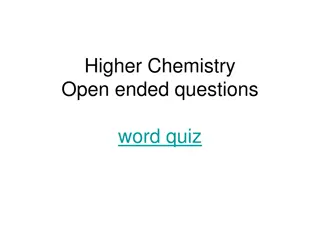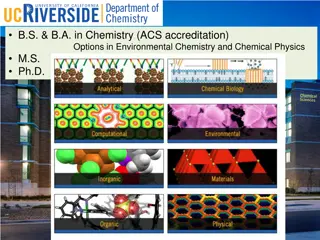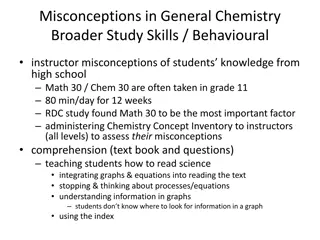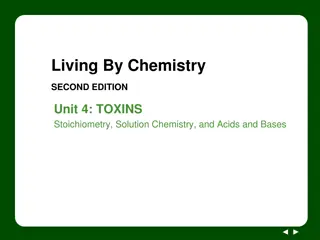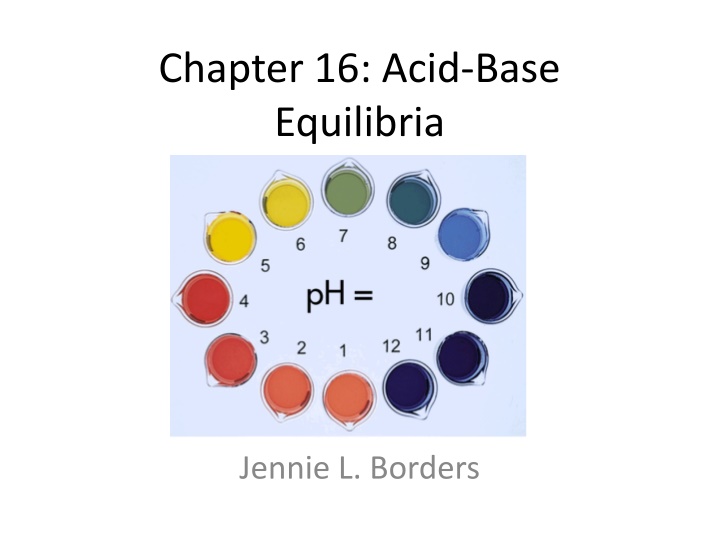
Acid-Base Equilibria: Definitions and Examples
Explore the fundamental concepts of acids and bases, including Arrhenius and Bronsted-Lowry definitions, conjugate acid-base pairs, and sample exercises. Learn about the properties of acids and bases, their roles in chemical reactions, and how they interact in equilibrium.
Download Presentation

Please find below an Image/Link to download the presentation.
The content on the website is provided AS IS for your information and personal use only. It may not be sold, licensed, or shared on other websites without obtaining consent from the author. If you encounter any issues during the download, it is possible that the publisher has removed the file from their server.
You are allowed to download the files provided on this website for personal or commercial use, subject to the condition that they are used lawfully. All files are the property of their respective owners.
The content on the website is provided AS IS for your information and personal use only. It may not be sold, licensed, or shared on other websites without obtaining consent from the author.
E N D
Presentation Transcript
Chapter 16: Acid-Base Equilibria Jennie L. Borders
Section 16.1 Acids and Bases: A Brief Review Acids taste sour, react with metals, and change the color of indicators. Bases taste bitter, feel slippery, and change the color of indicators.
Arrhenius An Arrhenius acid is a substance that increases the concentration of H+ions when dissolved in water. HCl H++ Cl- An Arrhenius base is a substance that increases the concentration of OH-ions when dissolved in water. NaOH Na++ OH-
Section 16.2 Bronsted-Lowry Acids and Bases The Bronsted-Lowry definitions involve the transfer of H+ions from one substance to another. H+is sometimes called a proton. H3O+is called the hydronium ion and it forms when water gains an H+.
Bronsted-Lowry A Bronsted-Lowry acid is a substance that donates a proton (H+) to another substance. HBr + H2O H3O++ Br- A Bronsted-Lowry base is a substance that accepts a proton (H+) from another substance. NH3+ H2O NH4++ OH-
Bronsted-Lowry To be a Bronsted-Lowry acid, the substance must be able to lose an H+ion. To be a Bronsted-Lowry base, the substance must have a nonbonding pair of electrons to bond with an H+ion. A substance that can act as an acid or base is amphiprotic. (Ex. H2O)
Conjugate Acid-Base Pairs A conjugate base is formed when an acid loses a proton. A conjugate acid is formed when a base gains a proton. A conjugate acid-base pair is a pair of substances that differ by one proton. HNO2+ H2O NO2-+ H3O+ acid base conjugate conjugate base acid
Sample Exercise 16.1 a. What is the conjugate base of each of the following acids: HClO4, H2S, PH4+, HCO3-? b. What is the conjugate acid of each of the following bases: CN-, SO4-2, H2O, HCO3-?
Practice Exercise Write the formula for the conjugate acid for each of the following: HSO3-, F-, PO43-, CO.
Sample Exercise 16.2 The hydrogen sulfite ion (HSO3-) is amphiprotic. a. Write an equation for the reaction of HSO3- with water, in which the ion acts as an acid. Identify the conjugate acid-base pairs.
Sample Exercise 16.2 cont b. Write an equation for the reaction of HSO3- with water, in which the ion acts as a base. Identify the conjugate acid-base pairs.
Practice Exercise When lithium oxide (Li2O) is dissolved in water, the solution turns basic from the reaction of the oxide ion (O2-) with water. Write the reaction that occurs, and identify the conjugate acid-base pairs.
Strong vs. Weak A strong acid or base fully dissociates into ions in solution. A weak acid or base on partially dissociates into ions in solution.
Strong vs. Weak If an acid is strong, then is conjugate base is weak. If an acid weak, then the conjugate base is strong.
Strength HX + H2O H3O+ + X- If H2O is a stronger base than X-, then the equilibrium will lie to the right. If H2O is a weaker base than X-, then the equilibrium will lie to the left.
Equilibrium Equilibrium favors the transfer of a proton between the stronger acid and stronger base to form the weaker acid and weaker base.
Sample Exercise 16.3 For the following proton-transfer reaction, use Figure 16.4 to predict whether the equilibrium lies predominately to the left (Kc <1) or to the right (Kc >1): HSO4- + CO32- SO42- + HCO3-
Practice Exercise For each of the following reactions, use Figure 16.4 to predict whether the equilibrium lies predominately to the left or to the right: a. HPO4- + H2O H2PO4- + OH- b. NH4+ + OH- NH3 + H2O
Section 16.3 The Autoionization of Water Autoionization is when a water molecule donates a proton to another water molecule.
Kw H2O + H2O H3O+ + OH- Kc = [H3O+][OH-] H3O+ = H+ At 25oC, Kw = [H+][OH-] = 1 x 10-14 When [H+] = [OH-], the solution is neutral.
Kw The value of Kw does not change with concentration. If [H+] increases, then [OH-] decreases and vice versa.
Sample Exercise 16.4 Calculate the values of [H+] and [OH-] in a neutral solution at 25oC.
Practice Exercise Indicate whether solutions with each of the following ion concentrations are neutral, acidic, or basic: a. [H+] = 4 x 10-9M b. [OH-] = 1 x 10-7M c. [OH-] = 7 x 10-13M
Sample Exercise 16.5 Calculate the concentration of H+ in a. A solution in which [OH-] is 0.010M. b. A solution in which [OH-] is 1.8 x 10-9M.
Practice Exercise Calculate the concentration of OH- in a solution in which a. [H+] = 2 x 10-6M b. [H+] = [OH-] c. [H+] = 100 x [OH-]
Section 16.4 The pH Scale pH = -log[H+] pH has no units. As pH decreases as [H+] increases. A change in [H+] by a factor or 10 causes the pH to change by 1.
Sample Exercise 16.6 Calculate the pH values for a. A solution in which [OH-] = 0.010M b. A solution in which [OH-] = 1.8 x 10-9M
Practice Exercise a. In a sample of lemon juice [H+] is 3.8 x 10- 4M. What is the pH? b. A commonly available window-cleaning solution has [OH-] = 1.9 x 10-6M. What is the pH?
Sample Exercise 16.7 A sample of freshly pressed apple juice has a pH of 3.76. Calculate [H+].
Practice Exercise A solution formed by dissolving an antacid tablet has a pH of 9.18. Calculate [H+].
pOH pOH = -log[OH-] The pOH scale is the opposite of the pH scale. pH + pOH = 14.00
Indicators Indicators are chemicals that change color as pH changes. Each indicator has its own pH range.
Section 16.5 Strong Acids and Bases Strong acids and bases are strong electrolytes and fully dissociate into ions in solution.
Strong Acids Seven commons strong acids: 1. HCl 2. HBr 3. HI 4. HNO3 5. HClO3 6. HClO4 7. H2SO4
Strong Acids When a strong acid is present in a solution, the [H+] from water is negligible compared to the acid.
Sample Exercise 16.8 What is the pH of a 0.040M solution of HClO4?
Practice Exercise An aqueous solution of HNO3 has a pH of 2.34. What is the concentration of the acid?
Strong Bases Common strong bases: 1. Alkali metal hydroxides 2. Heavy alkaline metal hydroxides (Ca, Sr, and Ba)
Sample Exercise 16.9 What is the pH of a. A 0.028M solution of NaOH b. A 0.0011M solution of Ca(OH)2
Practice Exercise What is the concentration of a solution of a. KOH for which the pH is 11.89 b. Ca(OH)2 for which the pH is 11.68
Metal Oxides Metal oxides dissolve to form a basic solution. Na2O 2Na+ + O2- O2- + H2O 2OH-
Section 16.6 Weak Acids HA H+ + A- Ka = [H+][A-] [HA] Ka is the acid-dissociation constant. The larger the value of Ka, the stronger the acid.
Sample Exercise 16.10 A student prepared a 0.10M solution of formic acid (HCOOH) and measured its pH. The pH at 25oC was found to be 2.38. Calculate Ka for formic acid at this temperature.
Practice Exercise Niacin, one of the B vitamins, has the following molecular structure: A 0.020M solution of niacin has a pH or 3.26. What is the acid-dissociation constant, Ka, for niacin?
Percent Ionization Percent ionization can also measure acid strength. Percent Ionization = [H+]equilibrium x 100 [HA]initial
Sample Exercise 16.11 A 0.10M solution of formic acid (HCOOH) contains 4.2 x 10-3M H+. Calculate the percentage of the acid that is ionized.
Practice Exercise A 0.020M solution of niacin has a pH of 3.26. Calculate the percent ionization of the niacin.
Using Ka to Calculate pH Set up an ICE chart like we did in the previous chapter. However, if Ka is small (normally 10-5 or less), then we can skip the quadratic equation by making an assumption.
Sample Exercise 16.12 Calculate the pH of a 0.20M solution of HCN. The Ka value is 4.9 x 10-10.
Practice Exercise The Ka for niacin is 1.5 x 10-5. What is the pH of a 0.010M solution of niacin?









